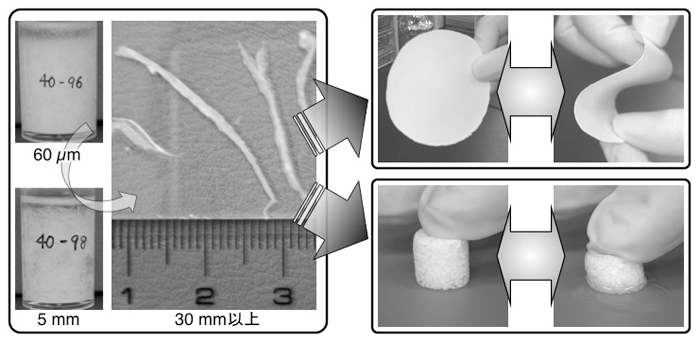Name
Bioceramics Group, Biomaterials Unit, Nano-Life Field, International Center for Materials Nanoarchitectonics, National Institute for Materials Science
National Institute for Materials Science
Outline
To realize a society where people can lead safe, healthy and comfortable lives, we conduct research to contribute to the development of next-generation medical treatment technologies, including regenerative medicine and nano drug delivery systems (nano DDS), as well as safety evaluation technologies such as bioelectronics.
To this end, we apply nanotechnologies to systematic researches in the interdisciplinary of material and bio sciences from the perspective of gene expression/control, and then develop nano biomaterials and devices with innovative functions that are useful for disease treatments, etc.
Research
Scaffold material (biomaterial) development
In these two decades, regenerative medicine to repair damaged tissues has been being studied around the world. For regenerative medicine, the development of scaffold materials (biomaterials) that control the proliferation, differentiation and induction of cells is indispensable. We have been developing scaffold materials with controlled nano to micro structures using calcium phosphates and proteins that easily incorporate into living organisms.


Development of biomaterials with nano to micro structures
Cells were considered to recognize the physicochemical properties of ingredients for proliferation, differentiation and induction. Based on nanostructure control technology, which has been missing from conventional biomaterial development, we have been developing nano to micro-structured biomaterials that can control biological and drug-release functions. The control of nano to micro structures makes it possible to fabricate biomaterials that can activate cell functions, like artificial bone material shown in the figure, which is recognized as bone by the cells and incorporated bone remodeling metabolism.
Synthesis of calcium phosphate-based material with accurately controlled structures
In regenerative medicine, scaffold materials that maintain tissue regeneration space in which support effective cell proliferation and differentiation are indispensable to regenerate massive tissue defect. Such materials must have the ability to regenerate moderate loss without transplanting cultured cells. We have shown that moderate bone defect can be regenerated only with ceramics-based materials having controlled nanostructure.
In this study, we will further improve our pursuit to combine precise control of nano-/macro- structures and complexation of biofunctional molecular, thereby achieving material therapy in which massive tissue defect is safely and surely regenerated only with materials. This will eliminate the need for cell culture in most cases, shortening the therapeutic time and reducing the medical costs.
Knowledge and technologies
Basic technologies for material-related research and development
- Calcium phosphate synthesis technology
- Calcium phosphate ceramics manufacturing technology
- Calcium phosphate/organic polymer composite synthesis technology
Basic technologies for bio-related research and development
- Cell culture technology
- Molecular biological analysis technology (PCR, real-time PCR, protein analysis, etc.)
- Optical, confocal microscope technology
Technologies and knowledge necessary for research and development related to nanotechnology
- Scanning electron microscope technology
- Atomic force microscope technology
Keywords
Regenerative medicine, biomaterial
Member
- Guest Professor: Masanori Kikuchi
National Institute for Materials Science
Contact
Address: Bioceramics Group, Biomaterials Unit, Nano-Life Field, International Center for Materials Nanoarchitectonics, National Institute for Materials Science
Namiki 1-1, Tsukuba, Ibaraki, 305-0044